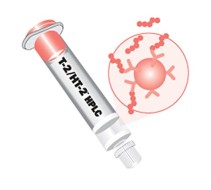
ChromShell columns and solvents
There are several critical characteristics that must be taken into consideration when selecting the appropriate organic solvent to use in the mobile phase with ChromShell® columns. Viscosity is one of the most important as high viscosity solvents may produce backpressures that are too high for the HPLC system used. Other important solvent characteristics include UV cutoff, cost and polarity index; where a solvent with a high UV cutoff will result in poor sensitivity with UV/Vis detection and use of high cost solvents will result in a poor laboratory that can't afford to buy new columns. Solvents with low polarity indices generally result in faster elution of organic compounds and are commonly used for column cleaning.
Acetonitrile
is arguably the best organic solvent as it results in the lowest system backpressure in water mixtures and also has a very low UV cutoff for better UV/Vis detection sensitivity. Although acetonitrile production is starting to increase with the turnaround of the economy, thus dropping cost, this still remains a major drawback of acetonitrile usage.
Methanol
is another popular organic solvent as it is comparable in elution strength to acetonitrile, has a relatively low UV absorbance, and is significantly less expensive than acetonitrile. The major drawback of methanol, especially when used with small particle size HPLC columns, is that its use can result in backpressures that exceed many HPLC system limits.
Acetone
is less commonly used as it has high UV absorbance, but can be used successfully if analytes absorb at higher UV wavelengths or if other detector types such as MS are used as it has similar elution properties to acetonitrile but is significantly less expensive.
Ethanol
is generally not recommended as it results in very high backpressures in water mixtures.
Iso-, n-propanol
have relatively strong elution strength and are most commonly used in column cleaning at low flow rates as they also results in high backpressures.
Tetrahydrofuran
has similar elution strength to n-propanol but is less commonly used as it is much more expensive.
Table of approximate backpressure of a 50/50 water mixture on a 150 x 4.6 mm ChromShell column at 1.2 l/min and 20°C
| Solvent | Viscosity (cP) | Backpressure (bar) | Polarity index |
|---|---|---|---|
| Acetonitrile | 0.37 | 200 | 5.8 |
| Methanol | 0.60 | 390 | 5.1 |
| Acetone | 0.32 | 325 | 5.1 |
| Ethanol | 1.20 | 630 | 5.2 |
| n-Propanol | 2.27 | 650 | 3.9 |
| Tetrahydrofuran | 0.55 | 430 | 4.0 |
More information about HPLC solvents are available here.





 0
0
 0
0




